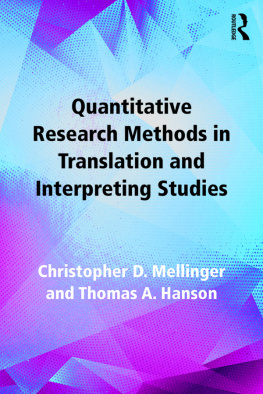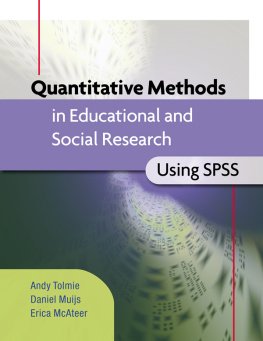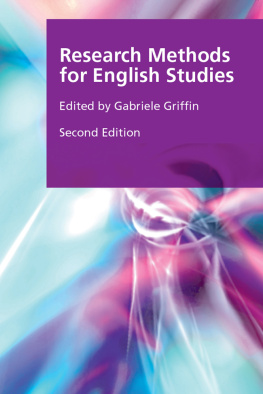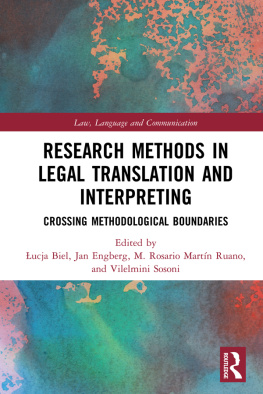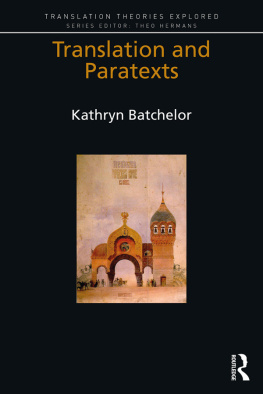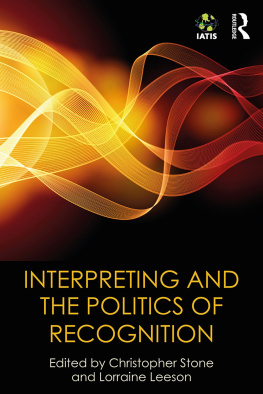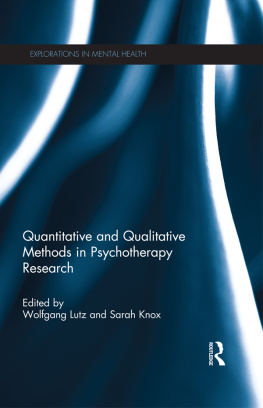Hanson Thomas A. - Quantitative research methods in translation and interpreting studies
Here you can read online Hanson Thomas A. - Quantitative research methods in translation and interpreting studies full text of the book (entire story) in english for free. Download pdf and epub, get meaning, cover and reviews about this ebook. year: 2016, publisher: Routledge, genre: Romance novel. Description of the work, (preface) as well as reviews are available. Best literature library LitArk.com created for fans of good reading and offers a wide selection of genres:
Romance novel
Science fiction
Adventure
Detective
Science
History
Home and family
Prose
Art
Politics
Computer
Non-fiction
Religion
Business
Children
Humor
Choose a favorite category and find really read worthwhile books. Enjoy immersion in the world of imagination, feel the emotions of the characters or learn something new for yourself, make an fascinating discovery.
- Book:Quantitative research methods in translation and interpreting studies
- Author:
- Publisher:Routledge
- Genre:
- Year:2016
- Rating:4 / 5
- Favourites:Add to favourites
- Your mark:
- 80
- 1
- 2
- 3
- 4
- 5
Quantitative research methods in translation and interpreting studies: summary, description and annotation
We offer to read an annotation, description, summary or preface (depends on what the author of the book "Quantitative research methods in translation and interpreting studies" wrote himself). If you haven't found the necessary information about the book — write in the comments, we will try to find it.
Hanson Thomas A.: author's other books
Who wrote Quantitative research methods in translation and interpreting studies? Find out the surname, the name of the author of the book and a list of all author's works by series.
Quantitative research methods in translation and interpreting studies — read online for free the complete book (whole text) full work
Below is the text of the book, divided by pages. System saving the place of the last page read, allows you to conveniently read the book "Quantitative research methods in translation and interpreting studies" online for free, without having to search again every time where you left off. Put a bookmark, and you can go to the page where you finished reading at any time.
Font size:
Interval:
Bookmark:

Quantitative Research Methods in Translation and Interpreting Studies
Quantitative Research Methods in Translation and Interpreting Studies encompasses all stages of the research process that include quantitative research methods, from conceptualization to reporting. In five parts, the authors cover:
sampling techniques, measurement, and survey design;
how to describe data;
how to analyze differences;
how to analyze relationships;
how to interpret results.
Each part includes references to additional resources and extensive examples from published empirical work. A quick reference table for specific tests is also included in the appendix. This user-friendly guide is the essential primer on quantitative methods for all students and researchers in translation and interpreting studies.
Accompanying materials are available online, including step-by-step walk-throughs of how analysis was conducted, and extra sample data sets for instruction and self study: https://www.routledge.com/9781138124967 . Further resources for Translation and Interpreting Studies are available on the Routledge Translation Studies Portal: http://cw.routledge.com/textbooks/translationstudies .
Christopher D. Mellinger is Assistant Professor of Spanish at Walsh University, USA and the managing editor of the journal Translation and Interpreting Studies.
Thomas A. Hanson is Assistant Professor of Finance at Minnesota State University Moorhead, USA.
Quantitative Research
Methods in Translation
and Interpreting Studies
Christopher D. Mellinger and
Thomas A. Hanson

First published 2017
by Routledge
2 Park Square, Milton Park, Abingdon, Oxon OX14 4RN
and by Routledge
711 Third Avenue, New York, NY 10017
Routledge is an imprint of the Taylor & Francis Group, an informa business
2017 Christopher D. Mellinger and Thomas A. Hanson
The right of Christopher D. Mellinger and Thomas A. Hanson to be identified as author of this work has been asserted by him/her in accordance with sections 77 and 78 of the Copyright, Designs and Patents Act 1988.
All rights reserved. No part of this book may be reprinted or reproduced or utilised in any form or by any electronic, mechanical, or other means, now known or hereafter invented, including photocopying and recording, or in any information storage or retrieval system, without permission in writing from the publishers.
Trademark notice: Product or corporate names may be trademarks or registered trademarks, and are used only for identification and explanation without intent to infringe.
British Library Cataloguing-in-Publication Data
A catalogue record for this book is available from the British Library
Library of Congress Cataloging-in-Publication Data
Names: Mellinger, Christopher D. (Christopher Davey), author. | Hanson, Thomas A. (Translator) author.
Title: Quantitative research methods in translation and interpreting studies / by Christopher D. Mellinger and Thomas A. Hanson.
Description: Milton Park, Abingdon, Oxon; New York, NY : Routledge, [2016] | Includes bibliographical references and index.
Identifiers: LCCN 2016007454| ISBN 9781138124950 (hardback) | ISBN 9781138124967 (pbk.) | ISBN 9781315647845 (ebook)
Subjects: LCSH: Translating and interpretingStudy and teachingResearch. | Translating and interpretingStudy and teachingMethodology. | Translating and interpretingResearch. | Quantitative research.
Classification: LCC P306.5 .M455 2016 | DDC 418/.020721dc23
LC record available at https://lccn.loc.gov/2016007454
ISBN: 978-1-138-12495-0 (hbk)
ISBN: 978-1-138-12496-7 (pbk)
ISBN: 978-1-3156-4784-5 (ebk)
Typeset in Times New Roman
by Swales & Willis Ltd, Exeter, Devon, UK
There are many people we would like to thank for their encouragement and support. We would first like to thank several friends and colleagues for taking time from their busy schedules to read and comment on various sections of the volume, including Brian Baer, Loubna Bilali, Jeff Child, Coral De Jess, Alan Hanson, Adrienne Hollowell, Katie Lyman, Michael Mellinger, Jonathan Mellinger, Scott St. Amand, Valerie Reed, and Leslie Whetstine. Their suggestions challenged us to rethink and revise the manuscript. We would also like to extend our thanks to Walsh Universitys Library and Division of Languages and Letters for their support. Sara Laviosa and the anonymous reviewer of the manuscript deserve our thanks for their insightful comments on the initial proposal, which undoubtedly improved the final project. Lastly, a heartfelt thank-you to our families for their encouragement and support throughout the entire process.
Every effort has been made to contact copyright-holders. Please advise the publisher of any errors or omissions, and these will be corrected in subsequent editions.
As translation and interpreting (T&I) studies evolve, investigators have incorporated novel research designs and methods to glean new insights on a broad range of research questions. Innovative data collection methods and their associated samples are drawn from a variety of sources for the purpose of describing specific phenomena and generalizing findings to larger populations. With the growth of quantitative data generated by new data collection toolssuch as eye-tracking software, keystroke logging, corpus linguistics tools, and audio and video recordingit is not surprising that scholars have looked to statistical methods to make sense of the data. The science of statistics provides a wealth of tools and methods that can be used to address and analyze the proliferation of data. Scholars engage these tools in a number of areas to identify patterns, evaluate relationships and differences, and generate new research questions.
Yet the inclusion of quantitative data in a field often associated with the humanities has left some scholars without the requisite foundation to read, interpret, and use statistics in their work. Graduate-level translation and interpreting programs, traditionally housed in comparative literature programs, do not regularly incorporate quantitative research methods in their curricula, and opportunities for formal study using empirical methods are scarce. Oakes and Ji (2012) note, for instance, that corpus-based translation studies have suffered from a lack of quantitative analytical methods, despite burgeoning attention being placed on corpus studies. OBrien (2009) describes the proliferation of data available when conducting eye-tracking studies that can prove unwieldly to the uninitiated. Likewise, Gile (2016) articulates the need for larger sample sizes in experimental research, though this requirement can prove problematic when attempting to recruit sufficient samples for T&I studies. Sun (2016) similarly describes growth in the use of quantitative data derived from survey instruments in the social sciences and its inclusion in translation and interpreting studies.
Systematic reflection on quantitative research methods has largely been limited to the types of statistical tests and analyses needed for specific studies and research projects. Some exceptions include articles by Balling (2008), Steiner (2012), and Balling and Hvelplund (2015), as well as several contributions to Oakes and Jis (2012) edited collection. These works have described specific approaches to various aspects of statistical analysis, but no book-length treatment on the topic is available. Discipline-specific research methods volumes often mention quantitative research methods but remain silent on the specifics of statistical analysis, presupposing an understanding on the part of readers. Consequently, researchers instead turn outside the discipline to related works, such as those by Johnson (2008), Rasinger (2008), and Turner (2014). While these volumes provide a foundation of quantitative analysis, they do not recognize the challenges inherent to research in T&I studies, nor do they provide a comprehensive overview that can address its specificities. This volume endeavors to fill this gap.
Next pageFont size:
Interval:
Bookmark:
Similar books «Quantitative research methods in translation and interpreting studies»
Look at similar books to Quantitative research methods in translation and interpreting studies. We have selected literature similar in name and meaning in the hope of providing readers with more options to find new, interesting, not yet read works.
Discussion, reviews of the book Quantitative research methods in translation and interpreting studies and just readers' own opinions. Leave your comments, write what you think about the work, its meaning or the main characters. Specify what exactly you liked and what you didn't like, and why you think so.

